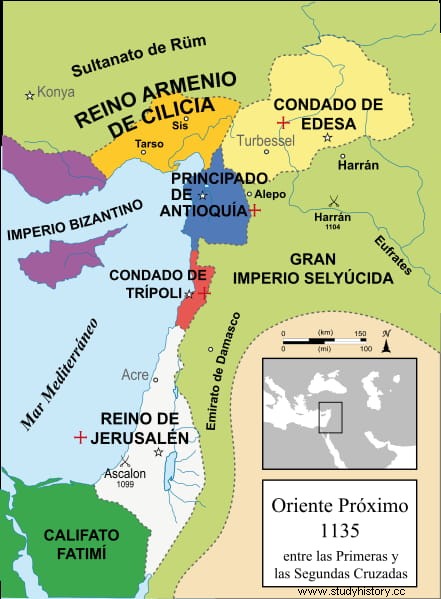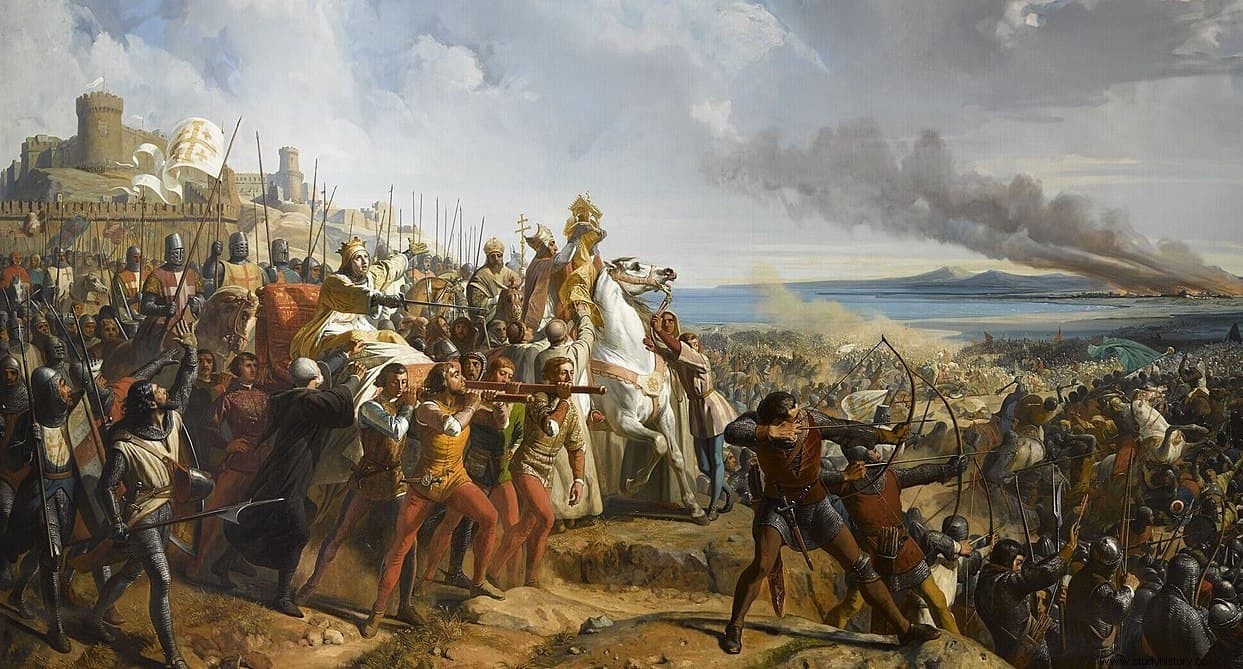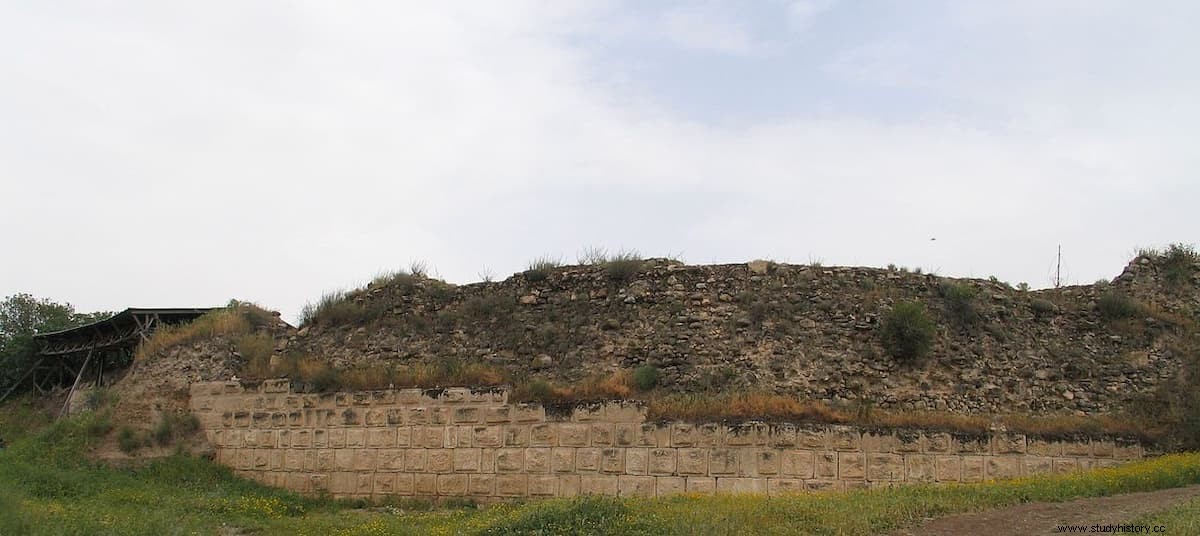The clashes between Saladin and Baldwin IV during the twelfth century, in the years that followed the Second Crusade, were a fierce exchange of blows in which each victory was followed by defeat and vice versa. The so-called Leper King scored a resounding triumph in Montgisard that allowed him to save in extremis the Kingdom of Jerusalem, but his rival would have the opportunity to take revenge a year and a half later, in the Battle of Marjayoun (or Marj-Ayyun), which would turn the tables by laying the foundations for the Third Crusade.
Jerusalem was precisely the objective of the campaign in which the war was framed, initiated by Saladin at the head of his Ayyubid army (the dynasty he founded when he proclaimed himself sultan of Egypt in the year 1171, although still depending on the Syrian one, there are those who delay the date a decade). He had replaced the deceased Fatimid caliph Al Adid, whom the Syrian sultan Nur al-Din had ordered to overthrow for being a heretic (he was a Shiite and he was a Sunni), and from that favorable position he conquered North Africa and the Arabian Peninsula, becoming so powerful that it set off alarm in Nur al-Din.
The death of the latter in the year 1174, when he was preparing to fight Saladin, meant the fall of Damascus, since his successor was only a child. Saladin did not want to act against him because legally she was his superior, but to prevent others from doing so, he became regent. From that position he acted against every possible enemy, starting with the zanguies and continuing with the famous hashasin who tried to make an attempt on his life. Three years later his dominions had extended to almost the entire Near and Middle East, but there was an island in the middle of them that broke the continuity:the Kingdom of Jerusalem.

It was a Christian state created in the year 1099, after the success of the First Crusade, whose territory extended by part of present-day Israel, Palestine, Jordan and Lebanon. In 1174 Baldwin IV ascended his throne, inheriting it from his father Amalric I. He was only thirteen years old - an age considered to be entering adulthood at the time - and on top of that it was discovered that he suffered from leprosy, which is why he had to hide his face behind a mask and was not supposed to live long. That, added to the fact that the bulk of the Crusader troops had marched north to besiege Harem, prompted Saladin to try to take over the entire region; after all, he had already sacked Jerusalem in a quick raid in 1170.
As we said at the beginning, it crashed unexpectedly in the battle of Montgisard when Baldwin, who seemed to be retreating and had few troops, took advantage of the fact that the Ayyubids had broken up their men in search of provisions to fall on them while they were fording a river. The disaster was of such dimension that Saladin had to flee hurriedly and painfully to Egypt on the back of a camel, with a ninety percent casualty among his own. It was his first defeat in pitched battle so far, but he managed to save his life and thus was able to prepare a second invasion.
He began it in 1179, this time focused on subduing Baldwin, who despite the omens and the fact that his illness made it increasingly difficult for him to personally lead the army -he could barely hold weapons with his sore hands-, not only was he still alive but his prestige had increased when he considered that, despite everything, God granted him his favor before the infidels . They advanced in the direction of Damascus, camping in Banias, an oasis in the Golan Heights that in ancient times was used as a sanctuary for the god Pan. provisioning of the Christian forces.

In fact, there was another objective, which was to eliminate a fortress located in the Ford of Jacob and called Le Chatellet (Beit el-Ahzan, for the Arabs). A site of great strategic value because it commanded a crossroads and the only feasible point to cross the Jordan River; since it was also only a day's march from Damascus, it was another of those obstacles that undermined the sultan's authority. And that did not give time to finish it because the original plans gave it a size similar to that of the Crac de los Caballeros; instead, only one tower had been built and the battlements were ten meters high.
From Le Chatellet, the Templars carried out regular raids that devastated the Muslim towns, actions that occasionally degenerated into minor skirmishes. In any case, a nuisance that Saladin had tried to settle by negotiating with the Christians the abandonment of the fortress; He even offered them up to one hundred thousand dinars if they dismantled the place and put an end to the raids, but his interlocutors were the military orders, who refused any pact. So, after bracing himself for a year and a half, he decided to take up arms.
Aware of the danger, Baldwin mobilized his men and marched to Tiberias, the largest city in Galilee (in the north of present-day Israel), then continued on to Safed and Toron. The latter was a Lebanese city, close to Tyre, where he met with the Templar contingent of the Grand Master Eudes de Saint Amand, the Hospitaller of Roger de Moulins and the army of Raymond III, Count of Tripoli. On June 10, 1179, the king was able to contemplate from the hills the camp of his enemy, whose troops were confident because they returned, exhausted, from a raid. Remembering that Montgisard's victory came under similar circumstances, he decided to attack immediately.

The descent down the slopes was vertiginous. The cavalry, driven by their momentum, left the infantry behind and fell on the Mohammedan host, easily defeating them. Too much, in fact, because that led Christian soldiers to trust; and to take the rest of the day to rest and plunder the dead. Raymond III's men and the Templars settled on a small orographic elevation between the town of Marjayoun and the Litani River (the longest in Lebanon, which runs parallel to the coast). And so things were, enjoying what was thought to be a great success, when suddenly the bulk of the Ayyubid army appeared under Saladin. The victory had been over a small part only, the vanguard, and now the rest arrived.
In general, the documentary sources on the battle blame Eudes de Saint Amand for the catastrophe that ensued, because despite discovering the Muslims with a little more time thanks to the hill he occupied, he refused to fall back to warn Baldwin and, on the contrary, he insisted on facing the enemy. It should not be strange, on the other hand, since the Order of the Temple was independent and was not subject to the monarch; it was a relationship between equals -allies but equals-, each with their own strategic interests even when they had a common enemy. In any case, the Grand Master personally paid for his mistake because not only did he see how his troops were massacred, but he himself fell prisoner and would die in captivity in 1180, without having time to finalize the negotiations to exchange him for some of Saladin's own nephews.

Raymond III, who was camped on the same hill and also sent his men to clash, was able to escape and take refuge in Tire but one of his stepsons, Hugh of Saint Omer, was captured. Baldwin had a hard time because his physical deterioration prevented him from riding and he had to be pulled to safety by a knight who led him on his horse while his personal guard slashed their way through the chaos of fighting soldiers. It is not known how many casualties there were on either side, although more than a hundred and a half illustrious Christians were captured. But it was a disaster for them because the defeat was the first of Saladin's long series of victories over the Christians, and it opened the door for him to take over the entire Syrian-Palestinian strip.
And it is that, while the survivors sheltered eight kilometers further on, in the castle of Beaufort (a stronghold seized in 1139 from the Saracens, who called it Apamea-Shaqif , that is to say, castle of the high rock, because it crowned a cliff), the king of Jerusalem must have understood with bitterness that he was no longer in a position to continue leading his people on campaign. In fact, there were still difficult moments ahead because, in August, the enemy felt capable enough to attack El Chatellet directly. Baldwin had to draw strength from weakness and start marching there to help him.
As he trudged through the relentless summer heat, aggravated by a persistent drought, Saladin's catapults bombarded the castle and sappers dug a tunnel that within five days caused the wall to collapse and open a breach through which the Muslims entered. Eight hundred defenders were put to the sword and the seven hundred who surrendered would suffer the same end, the bodies being used to contaminate the water wells and thus prevent the Christians from settling there again. Curiously, this brutal treatment contrasted with that which the doctor Soleim Al-Razi had dispensed to the wounded from both sides of Marjayoun.

Next, as much as possible of the defenses of El Chatellet were demolished and the site was abandoned hastily for two reasons:the first was that an epidemic began to decimate the ranks and killed a dozen commanders; the second, that Baldwin was approaching. He arrived six hours late but, as compensation, in 1183 he would manage to prevent the fall of Kerak and conquer Eliat, just a year before leprosy finally overcame him; Luckily, he was spared seeing how his kingdom fell two years later at the hands of Saladin, who for all this and despite being enemies, admired and respected him.
